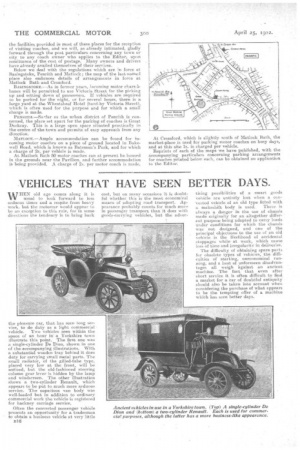VEHICLES THAT HAVE SEEN BETTER DAYS.
Page 20

If you've noticed an error in this article please click here to report it so we can fix it.
WHEN old age conies along it is usual to look forward to less arduous times and a respite from heavy work, but the motorcar would appear to be an exception to this rule, for in some directions the tendency is to bring back
the pleasure car, that has seen long service, to de duty as a light commerciat
vehicle. Two vehicles seen within the space of an hour in a -Yorkshire town illustrate this point. The first one was a single-cylinder De Dion, shown in one of the accompanying illustrations, With a substantial wooden tray behind it does duty for carrying small metal parts. The small radiator, of the gilled-tube type, placed very low at the front, will be noticed; but. the old-fashioned steering column gear lever is hidden by the lamp and windscreen. The other illustration shows a two-cylinder Renault, which appears to be put. to MUCh more arduous service. The capacious van body was well-loaded but in addition to ordinary commercial work the vehicle is registered for hackney carriage service.
Often the converted passenger vehicle presents an opportunity for a tradesman to obtain a business vehicle at very little i316 cost, but on many occasions it is doubtful whether this is the most economical means of adopting road transport. Appearance probably counts for much more in passenger transport than it does with goods-carrying vehicles, but the adver, thing possibilities of a smart goods vehicle are entirely lost when a con. veiled vehicle of an old type fitted with a, makeshift body is used. There is always a danger in the use of chassis made originally for art altogether different purpose being adapted to carry loads under conditions for which the chassis was not designed, and one of the principal objections to the use of an old vehicle is the likelihood of accidental stoppages whileat work, which cause loss of time and irregularity in deliveries.
The difficulty of obtaining spare parts for obsolete types of vehicles, the difficulties of starting, uneconomical running, and a host of unforeseen disadvantages all weigh 'against an ancient, machine. The fact that, even after short. service it is often difficult to find a market for a Car of doubtful antiquity should also be taken into account when considering the purchase of what appears to he the tempting offer of a machine which has seen better days.






























